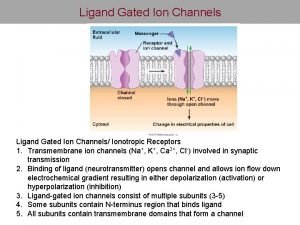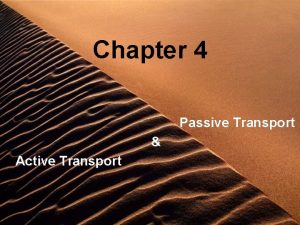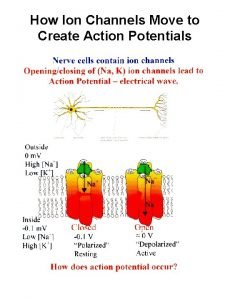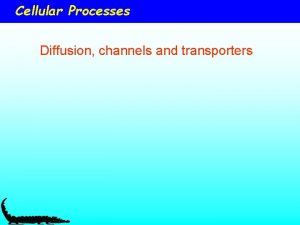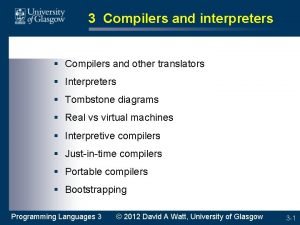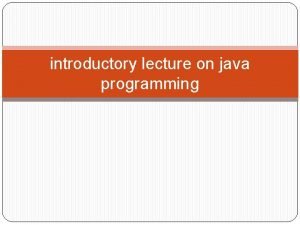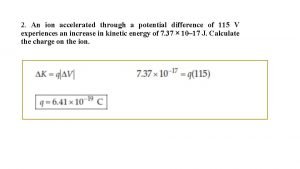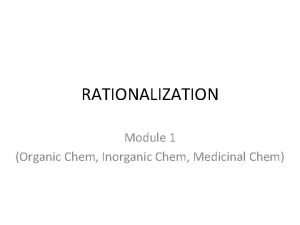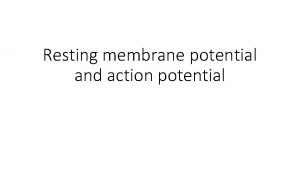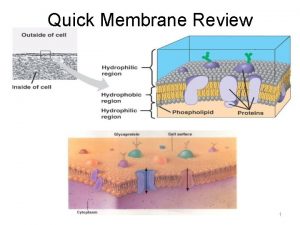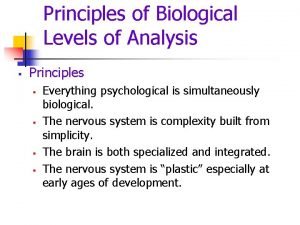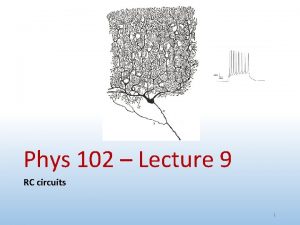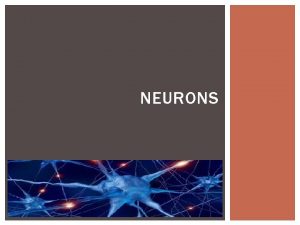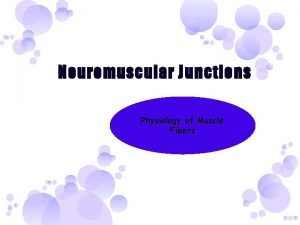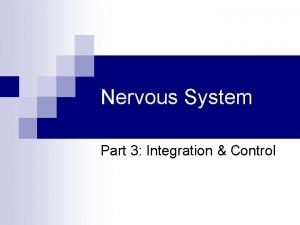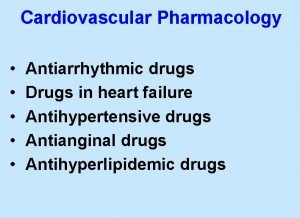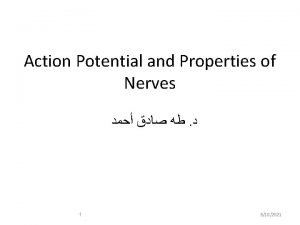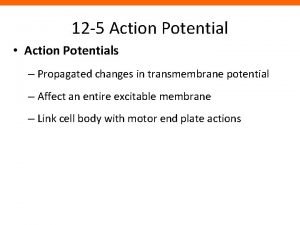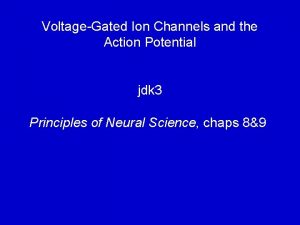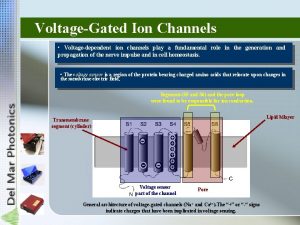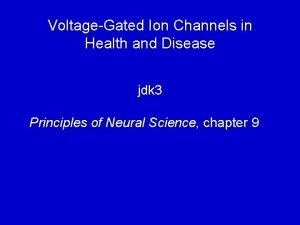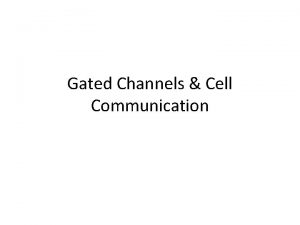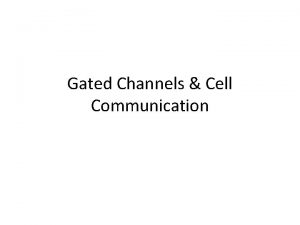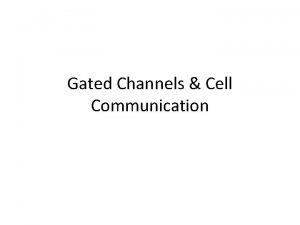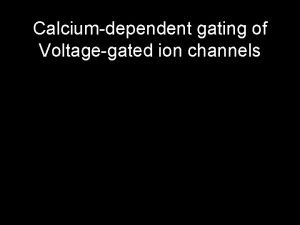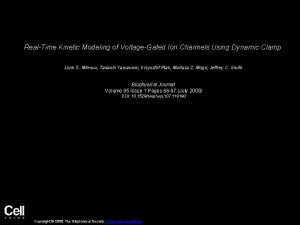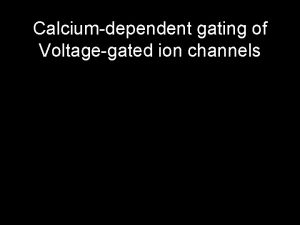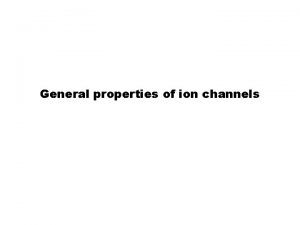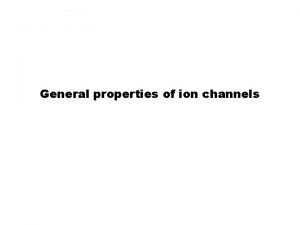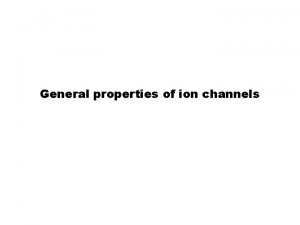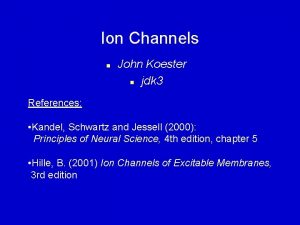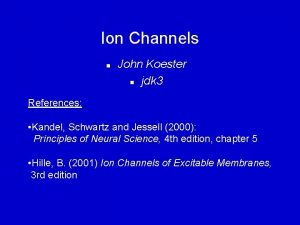VoltageGated Ion Channels and the Action Potential jdk

















































- Slides: 49

Voltage-Gated Ion Channels and the Action Potential jdk 3 Principles of Neural Science, chaps 8&9

Voltage-Gated Ion Channels and the Action Potential • The Action Potential – Generation – Conduction • Voltage-Gated Ion Channels – Diversity – Evolutionary Relationships

Electrical Signaling in the Nervous System is Caused by the Opening or Closing of Ion Channels PNS, Fig 2 -11

Electrical Signaling in the Nervous System is Caused by the Opening or Closing of Ion Channels + - + + + - - - + + + -+ + The Resultant Flow of Charge into the Cell Drives the Membrane Potential Away From its Resting Value

Electronically Generated Clamp Current Counterbalances the Na+ Membrane Current Command g = I/V PNS, Fig 9 -2

Equivalent Circuit of the Membrane Connected to the Voltage Clamp Im VC Imon

For Large Depolarizations, Both INa and IK Are Activated PNS, Fig 9 -3

Tetrodotoxin

IK is Isolated By Blocking INa PNS, Fig 9 -3

INa is Isolated By Blocking IK PNS, Fig 9 -3

Vm = the Value of the Na Battery Plus the Voltage Drop Across g. Na Im VC PNS, Fig 9 -5

Calculation of g. Na Vm = ENa + INa/g. Na PNS, Fig 9 -3

Calculation of g. Na Vm = ENa + INa/g. Na INa = g. Na (Vm - ENa) PNS, Fig 9 -3

Calculation of g. Na Vm = ENa + INa/g. Na INa = g. Na (Vm - ENa) g. Na = INa/(Vm - ENa) PNS, Fig 9 -3

g. Na and g. K Have Two Similarities and Two Differences PNS, Fig 9 -6

Voltage-Gated Na+ Channels Have Three States PNS, Fig 9 -9

Total INa is a Population Phenomenon PNS, Fig 9 -3

The Action Potential is Generated by Sequential Activation of g. Na and g. K PNS, Fig 9 -10

A Positive Feedback Cycle Underlies the Rising Phase of Action Potential Open Na+ Channels Depolarization Fast Inward INa

Slower Negative Feedback Cycle Underlies Falling Phase of the Action Potential Increased g. K+ Na+ Inactivation Slow Open Na+ Channels Fast Depolarization Inward INa

Local Circuit Flow of Current Contributes to Action Potential Propagation PNS, Fig 8 -6

Conduction Velocity Can be Increased by Increased Axon Diameter and by Myelination Increased Axon Diameter ra I d. V/dt

Conduction Velocity Can be Increased by Increased Axon Diameter and by Myelination Increased Axon Diameter ra Myelination + I Cm d. V/dt + +++ --- ∆V = ∆Q/C --- -

Myelin Speeds Up Action Potential Conduction PNS, Fig 8 -8

Voltage-Gated Ion Channels and the Action Potential • The Action Potential – Generation – Conduction • Voltage-Gated Ion Channels – Diversity – Evolutionary Relationships

Opening of Na+ and K + Channels is Sufficient to Generate the Action Potential Falling Phase Rising Phase + + + - - - K+ + + - - - + + + + - - + -+ + - + + + -+ - + Na + Open + Na Na + Channels Close; K+ Channels Open + + Channels Na + +

However, a Typical Neuron Has Several Types of Voltage-Gated Ion Channels + + - - + - + +

Functional Properties of Voltage-Gated Ion Channels Vary Widely • Selective permeability • Kinetics of activation • Voltage range of activation • Physiological modulators

Voltage-Gated Ion Channels Differ in their Selective Permeability Properties Cation Permeable Na+ K+ Ca++ Na+, Ca++, K+ Anion Permeable Cl -

Functional properties of Voltage-Gated Ion Channels Vary Widely • Selective permeability • Kinetics of activation • Voltage range of activation • Physiological modulators

Voltage-Gated K+ Channels Differ Widely in Their Kinetics of Activation and Inactivation V I Time

Functional properties of Voltage-Gated Ion Channels Vary Widely • Selective permeability • Kinetics of activation • Voltage range of activation • Physiological modulators

Probability of Channel Opening Voltage-Gated Ca++ Channels Differ in Their Voltage Ranges of Activation

Probability of Channel Opening The Inward Rectifier K+ Channels and HCN Channels Are Activated by Hyperpolarization

Functional properties of Voltage-Gated Ion Channels Vary Widely • Selective permeability • Kinetics of activation • Voltage range of activation • Physiological modulators: e. g. , phosphorylation, binding of intracellular Ca++ or cyclic nucleotides, etc.

Physiological Modulation

HCN Channels That Are Opened by Hyperpolarization Are Also Modulated by c. AMP Probability of Channel Opening +c. AMP -120 -90 -60

Voltage-Gated Ion Channels Belong to Two Major Gene Superfamilies I. Cation Permeant II. Anion Permeant

Voltage-Gated Ion Channel Gene Superfamilies I) Channels With Quatrameric Structure Related to Voltage-Gated, Cation-Permeant Channels: A) Voltage-gated: • K+ permeant • Na+ permeant • Ca++ permeant • Cation non-specific permeant

Voltage-Gated Ion Channel Gene Superfamily I) Channels With Quatrameric Structure Related to Voltage-Gated, Cation-Permeant Channels: A) Voltage-gated: • K+ permeant • Na+ permeant • Ca++ permeant • Cation non-specific permeant (HCN) Structurally related to- B) Cyclic Nucleotide-Gated (Cation non-specific permeant) C) K+-permeant leakage channels D) TRP Family (cation non-specific); Gated by various stimuli, such as osmolarity, p. H, mechanical force (Stretch or sound), ligand-binding and temperature

The a-Subunits of Voltage-Gated Channels Have Been Cloned PNS, Fig 6 -9

Voltage-Gated Cation-Permeant Channels Have a Basic Common Structural Motif That is Repeated Four-fold PNS, Fig 9 -14

Four-Fold Symmetry of Voltage-Gated Channels Arises in Two Ways K+ Channels, HCN Channels Na+ or Ca++ Channels I II III x 4 I IV II IV

P-Loops Form the Selectivity Filter of Voltage-Gated Cation-Permeant Channels PNS, Fig 9 -15

Ion Channels Evolve in a Modular Fashion

Modular Construction of K+ Channels

Voltage-Gated Ion Channel Gene Superfamilies II) “CLC” Family of Cl--Permeant Channels (dimeric structure): Gated by: • Voltage - particularly important in skeletal muscle • Cell Swelling • p. H

Voltage-Gated Cl- Channels Are Dimers They Differ in Sequence and Structure from Cation-Permeant Channels x 2

 Types of graded potentials
Types of graded potentials Graded potential vs action potential
Graded potential vs action potential Graded potential definition
Graded potential definition Graded potential vs action potential
Graded potential vs action potential Graded potential vs action potential
Graded potential vs action potential Source of bioelectric potential is
Source of bioelectric potential is Hypopolarization
Hypopolarization End-plate potential vs action potential
End-plate potential vs action potential Action potential resting potential
Action potential resting potential Action potential resting potential
Action potential resting potential Transmembrane ligand gated ion channel
Transmembrane ligand gated ion channel Are ion channels passive or active
Are ion channels passive or active Ion channels
Ion channels Ion channels facilitated diffusion
Ion channels facilitated diffusion Jdk provides an interpretive compiler for java.
Jdk provides an interpretive compiler for java. Spring mvc 로그인
Spring mvc 로그인 Indifident
Indifident Jdk berisi sekumpulan
Jdk berisi sekumpulan Project loom jdk
Project loom jdk Ion dipolo
Ion dipolo Ejemplo de fuerza ion ion
Ejemplo de fuerza ion ion Fuerzas dipolo-dipolo ejemplos
Fuerzas dipolo-dipolo ejemplos Force de london
Force de london An ion accelerated through a potential difference of
An ion accelerated through a potential difference of Equipotential lines
Equipotential lines Potential unit
Potential unit How does water potential affect osmosis
How does water potential affect osmosis Market potential and forecasting
Market potential and forecasting Electric potential
Electric potential Potential due to dipole
Potential due to dipole Peelectric
Peelectric Electric potential
Electric potential Iselpin indication
Iselpin indication Flaccid cell
Flaccid cell How to find ionization constant for water potential
How to find ionization constant for water potential Osmotic potential vs water potential
Osmotic potential vs water potential Potential energy of capacitor
Potential energy of capacitor Goldman hodgkin katz equation
Goldman hodgkin katz equation Action potential sodium potassium
Action potential sodium potassium Refractory period neuron
Refractory period neuron Three phases of action potential
Three phases of action potential Action potential summary
Action potential summary Quizdraw
Quizdraw All or none principle of action potential
All or none principle of action potential All or none law
All or none law Frog heart
Frog heart Nodal action potential
Nodal action potential Action potential threshold
Action potential threshold Refractory period action potential
Refractory period action potential Generation of action potential
Generation of action potential










